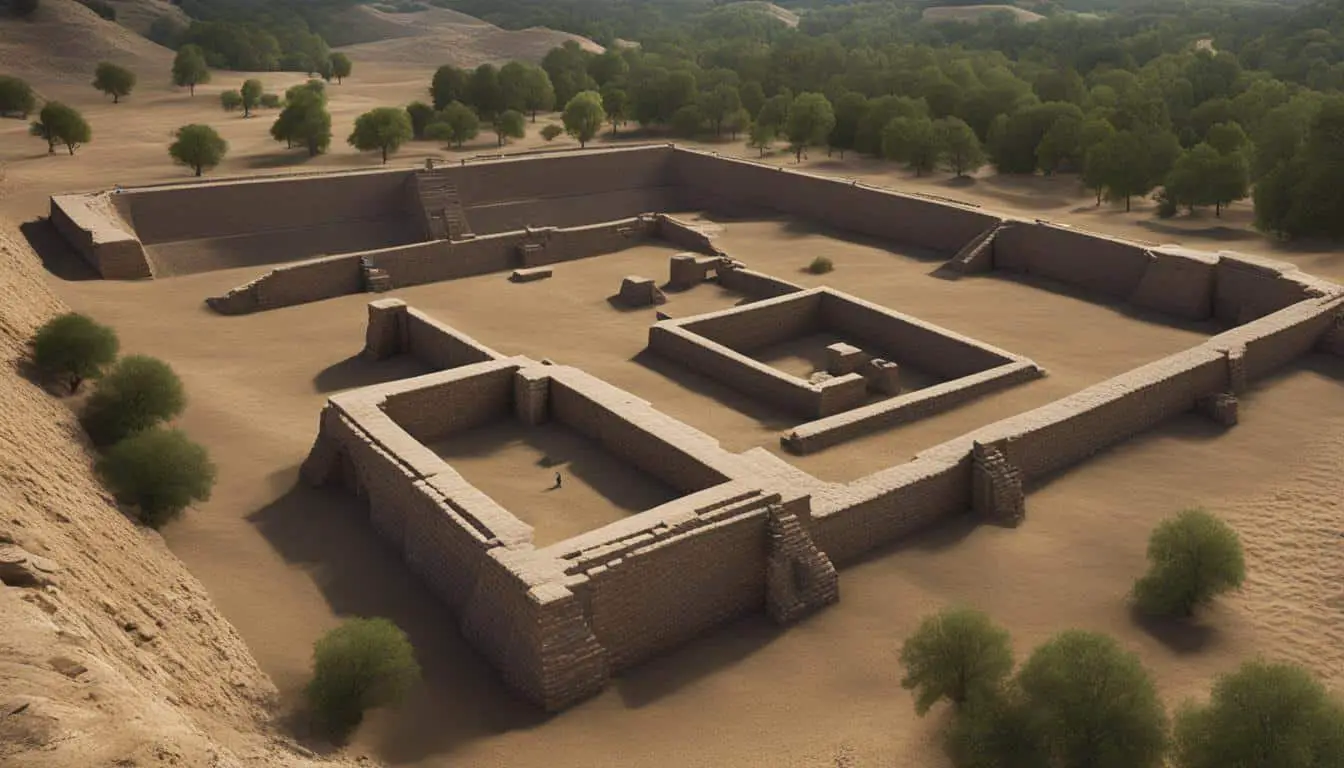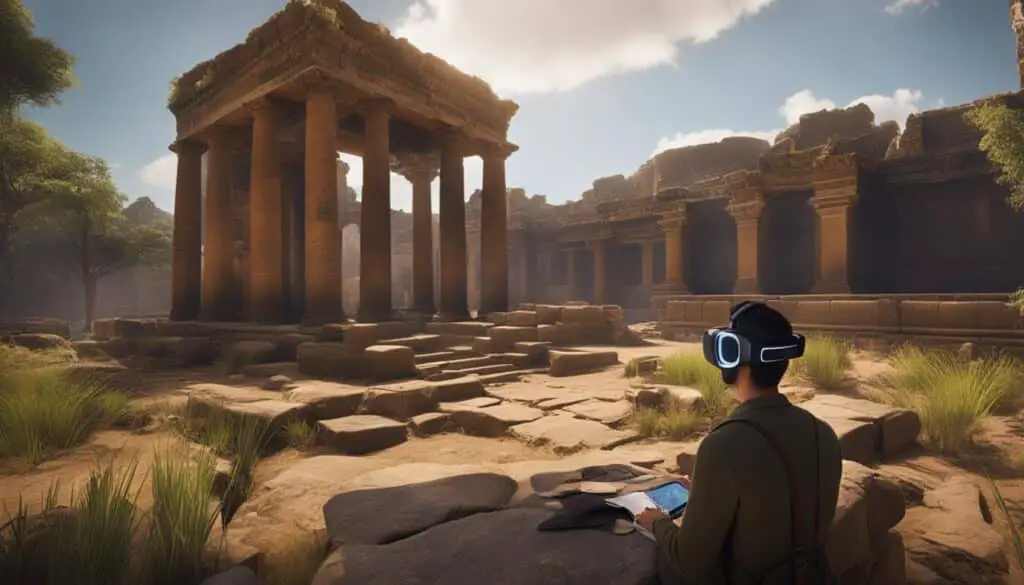
Artificial intelligence (AI) is revolutionizing the field of archaeology, transforming the way we discover and interpret the past. By harnessing the power of AI algorithms, researchers are unlocking hidden historical insights and pushing the boundaries of knowledge. The integration of AI in archaeology has given rise to new digital excavation methods, innovative data analysis techniques, and enhanced historical research methodologies. Let’s explore how AI is reshaping the world of archaeology and shedding light on our ancient civilizations.
Key Takeaways:
- AI technology is revolutionizing the field of archaeology, uncovering previously unknown historical insights.
- Digital excavation and machine learning algorithms are enabling researchers to analyze satellite imagery and identify buried archaeological sites.
- Data analysis powered by AI is uncovering patterns and connections in large datasets of artifacts, enhancing our understanding of ancient civilizations.
- AI technology allows for the reconstruction and visualization of ancient sites and artifacts in 3D, providing a more immersive experience.
- AI is helping to preserve and protect archaeological sites from threats such as looting and environmental damage.
The Impact of AI in Archaeological Research
The use of artificial intelligence (AI) in archaeological research has had a profound impact on the field. With advancements in technology, AI has accelerated the discovery process and improved accuracy in analyzing archaeological data. Through the application of AI algorithms, researchers can quickly analyze large datasets, categorize artifacts, and track the movement of goods and ideas in ancient civilizations.
A key area where AI has made significant contributions is in the analysis of ancient settlements. By utilizing data analysis techniques, AI algorithms can identify patterns and connections within settlement data that may have been overlooked by human researchers. This has led to new insights and a deeper understanding of how ancient societies functioned and evolved.
AI algorithms have revolutionized the way we approach pottery analysis. With the ability to quickly analyze and classify pottery samples, researchers can now discern production techniques, identify cultural variations, and even trace the trade routes of ancient civilizations. This level of detail has greatly enhanced our understanding of ancient cultures and their interactions.
Another area where AI has had a significant impact is in predictive modeling. By analyzing environmental factors and historical records, AI algorithms can predict the locations of undiscovered archaeological sites. This has revolutionized the way researchers approach fieldwork, saving time and resources by directing excavations to areas with a higher likelihood of yielding significant finds.
The Impact of AI in Heritage Preservation
In addition to aiding in archaeological research, AI technology has also played a crucial role in heritage preservation. Through the creation of digital models, AI allows for the virtual reconstruction of ancient structures, providing a unique and immersive experience for researchers and the general public.
Furthermore, AI-powered algorithms assist in artifact preservation by generating 3D models that can guide restoration efforts. These models capture intricate details of artifacts, ensuring their preservation for future generations to study and appreciate.
| Advancements in AI in Archaeology | Impact |
|---|---|
| Data Analysis | Accelerates the discovery process and improves accuracy in analyzing archaeological data. |
| Ancient Settlements | Identifies patterns and connections within settlement data, providing insights into ancient societies. |
| Pottery Analysis | Allows for quick analysis and classification of pottery, leading to a deeper understanding of ancient cultures and trade routes. |
| Predictive Modeling | Helps in identifying undiscovered archaeological sites, optimizing fieldwork and resource allocation. |
| Heritage Preservation | Enables virtual reconstruction of ancient structures and aids in artifact preservation through the creation of 3D models. |
The impact of AI in archaeology is undeniable. As technology continues to advance, AI holds great promise for the future of archaeological research, providing even faster and more accurate analysis of data. With AI as a valuable tool, researchers can continue to uncover hidden historical insights and deepen our understanding of the past.
The Future of AI in Archaeology
As we look ahead, the future of AI in archaeology holds immense potential for further advancements in our understanding of the past. With continued progress in AI technology, researchers will have access to even more powerful tools and capabilities to analyze and interpret historical data.
Advancements in AI:
One key area of development is in data analysis. AI algorithms will become increasingly sophisticated, allowing for faster and more accurate processing of large datasets. This will enable researchers to uncover hidden patterns and connections that may have previously gone unnoticed, providing valuable insights into ancient civilizations and their interactions.
Artifact Preservation:
Another exciting prospect is the use of AI for artifact preservation. By creating detailed digital models, AI can help conserve fragile artifacts and guide restoration efforts. These models can provide a valuable resource for future generations, ensuring the long-term preservation and accessibility of our shared cultural heritage.
Decipherment Efforts:
Deciphering ancient scripts and languages has always been a challenge for historians and archaeologists. However, with the aid of AI-powered algorithms, the process of decipherment can be accelerated. Machine learning techniques can analyze vast amounts of linguistic data, helping to identify language variations and uncover the meanings behind ancient writings.
Overall, the future of AI in archaeology is brimming with possibilities. From enhanced data analysis to improved artifact preservation and decipherment efforts, AI will continue to push the boundaries of archaeological research. By harnessing the power of AI, we can expect to unearth new historical insights and deepen our understanding of the fascinating civilizations that came before us.

Table: Advancements in AI in Archaeology
| Advancement | Description |
|---|---|
| Data Analysis | AI algorithms will enable faster and more accurate analysis of large datasets, uncovering hidden patterns and connections. |
| Artifact Preservation | AI-powered digital modeling will aid in the conservation and restoration of fragile artifacts, ensuring their long-term preservation. |
| Decipherment Efforts | AI algorithms will assist in deciphering ancient scripts and identifying language variations, advancing our understanding of ancient writings. |
Conclusion
Artificial intelligence (AI) has revolutionized the field of archaeology, providing researchers with powerful tools to uncover hidden historical insights. By utilizing AI algorithms, we can now analyze satellite imagery, sift through vast amounts of data, and reconstruct ancient sites and artifacts in stunning 3D detail.
The future of archaeology with AI looks incredibly promising. As technology continues to advance, so too will our ability to enhance research and make new discoveries. With the assistance of AI, we can delve deeper into the mysteries of the past and gain a better understanding of our human history.
AI technology in archaeology opens up endless possibilities. We can imagine AI algorithms assisting us in deciphering ancient scripts, identifying language variations in texts, and aiding in the preservation and restoration of fragile artifacts. AI’s potential to accelerate data analysis and aid in the discovery of undiscovered archaeological sites and artifacts is truly exciting.
With AI as our ally, we have the means to deepen our understanding of the past and preserve our shared cultural heritage for future generations. The future of archaeology is firmly intertwined with AI technology, and together, we will continue to uncover and appreciate historical discoveries that shape our understanding of the world.
FAQ
How is AI transforming the field of archaeology?
AI is revolutionizing archaeological research by enabling researchers to analyze satellite imagery, interpret large datasets of artifacts, reconstruct ancient sites and artifacts in 3D, and preserve and protect archaeological sites from threats.
What role does AI play in analyzing and interpreting archaeological data?
AI algorithms can quickly analyze large datasets of artifacts, categorize and date artifacts, identify production techniques, and track the movement of goods and ideas in ancient civilizations. AI also assists in predicting new archaeological sites by analyzing historical records and environmental factors.
How does AI enhance the preservation and restoration of artifacts?
AI technology aids in the preservation and restoration of fragile artifacts by creating digital models for conservation planning and generating virtual reconstructions of ancient structures. This allows for better conservation efforts and enhances our understanding of the past.
What can we expect from the future of AI in archaeology?
As AI technology continues to advance, we can expect faster and more accurate data analysis, aiding in the discovery of undiscovered archaeological sites and artifacts. AI will also assist in deciphering ancient scripts and identifying language variations in texts, enabling researchers to delve deeper into historical mysteries.
Source Links
- https://ts2.space/en/ai-in-archaeology-a-catalyst-for-new-discoveries-and-insights/
- https://medium.com/@mohsinali73a/title-ai-in-archaeology-revealing-ancient-mysteries-through-technology-b1faf238e7ad
- https://moderndiplomacy.eu/2023/09/13/the-artificial-intelligence-which-looks-back-to-the-past-the-development-of-contemporary-archaeology/








